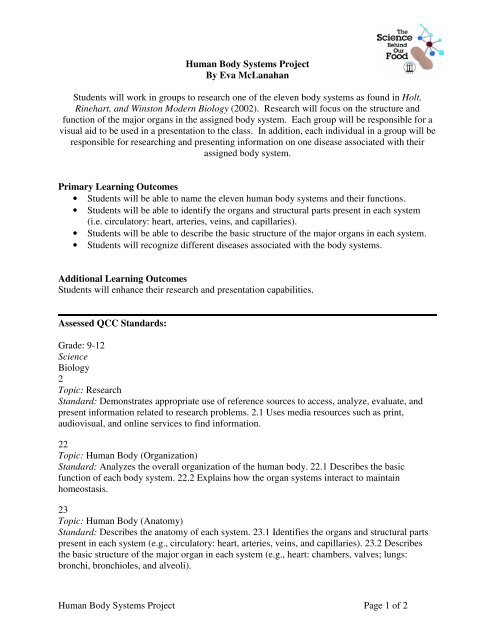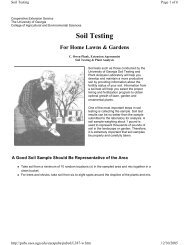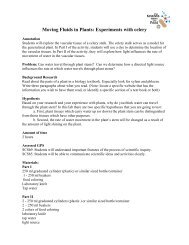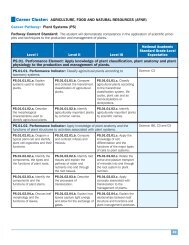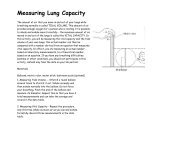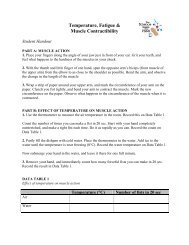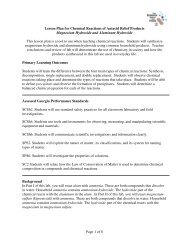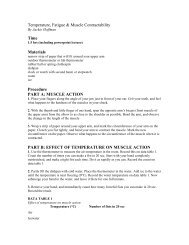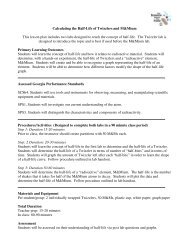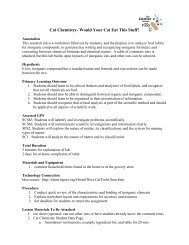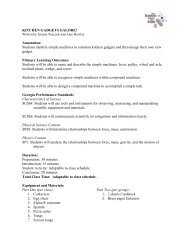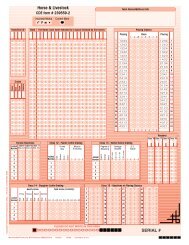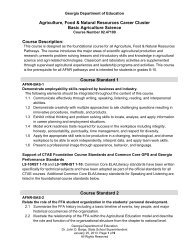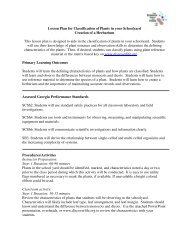Human Body Systems Project Page 1 of 2 Human Body Systems ...
Human Body Systems Project Page 1 of 2 Human Body Systems ...
Human Body Systems Project Page 1 of 2 Human Body Systems ...
You also want an ePaper? Increase the reach of your titles
YUMPU automatically turns print PDFs into web optimized ePapers that Google loves.
<strong>Human</strong> <strong>Body</strong> <strong>Systems</strong> <strong>Project</strong>By Eva McLanahanStudents will work in groups to research one <strong>of</strong> the eleven body systems as found in Holt,Rinehart, and Winston Modern Biology (2002). Research will focus on the structure andfunction <strong>of</strong> the major organs in the assigned body system. Each group will be responsible for avisual aid to be used in a presentation to the class. In addition, each individual in a group will beresponsible for researching and presenting information on one disease associated with theirassigned body system.Primary Learning Outcomes• Students will be able to name the eleven human body systems and their functions.• Students will be able to identify the organs and structural parts present in each system(i.e. circulatory: heart, arteries, veins, and capillaries).• Students will be able to describe the basic structure <strong>of</strong> the major organs in each system.• Students will recognize different diseases associated with the body systems.Additional Learning OutcomesStudents will enhance their research and presentation capabilities.Assessed QCC Standards:Grade: 9-12ScienceBiology2Topic: ResearchStandard: Demonstrates appropriate use <strong>of</strong> reference sources to access, analyze, evaluate, andpresent information related to research problems. 2.1 Uses media resources such as print,audiovisual, and online services to find information.22Topic: <strong>Human</strong> <strong>Body</strong> (Organization)Standard: Analyzes the overall organization <strong>of</strong> the human body. 22.1 Describes the basicfunction <strong>of</strong> each body system. 22.2 Explains how the organ systems interact to maintainhomeostasis.23Topic: <strong>Human</strong> <strong>Body</strong> (Anatomy)Standard: Describes the anatomy <strong>of</strong> each system. 23.1 Identifies the organs and structural partspresent in each system (e.g., circulatory: heart, arteries, veins, and capillaries). 23.2 Describesthe basic structure <strong>of</strong> the major organ in each system (e.g., heart: chambers, valves; lungs:bronchi, bronchioles, and alveoli).<strong>Human</strong> <strong>Body</strong> <strong>Systems</strong> <strong>Project</strong> <strong>Page</strong> 1 <strong>of</strong> 2
24Topic: <strong>Human</strong> <strong>Body</strong> (Physiology)Standard: Describes the physiology <strong>of</strong> each system. 24.1 Identifies the function <strong>of</strong> eachstructural part in the human body system. 24.2 Explains how the parts interrelate in a functioningsystem.Procedures/ActivitiesStep: 1 Duration: 10-15 minutesForm groups and assign body system.Attachments for Step 1Title: <strong>Human</strong> <strong>Body</strong> <strong>Systems</strong> <strong>Project</strong> HandoutDescription: Student handout for human body systems project.Step: 2 Duration: Varies (three 90 minute class periods)Students conduct research on assigned body system and chosen associated disease. Research canbe conducted in the library or on the internet.Step: 3 Duration: Varies (two 90 minute class periods)Groups present the final stage <strong>of</strong> their project using at least one visual aid. All students willcomplete a chart on each body system while listening to the presentations.Attachments for Step 3Title: Presentation RubricDescription: Grading rubric for the oral presentation.Title: <strong>Body</strong> systems chartDescription: Chart for students to complete while listening to presentations.Materials and EquipmentReference material, poster board or butcher paper, pencils, markers, color pencilsTotal Duration1 week (five 90 minute class periods)Technology ConnectionInternet research, potential use <strong>of</strong> PowerPoint presentations as visual rather than poster board orbutcher paperAssessmentPresentation skills, presentation content, completion <strong>of</strong> body systems chart, quiz<strong>Human</strong> <strong>Body</strong> <strong>Systems</strong> <strong>Project</strong> <strong>Page</strong> 2 <strong>of</strong> 2
<strong>Human</strong> <strong>Body</strong> <strong>Systems</strong> <strong>Project</strong>Objectives:• Students will be able to name the eleven human body systems and their functions.• Students will be able to identify the organs and structural parts present in each system(i.e. circulatory: heart, arteries, veins, and capillaries).• Students will be able to describe the basic structure <strong>of</strong> the major organs in each system.• Students will enhance their research and presentation skills.Requirements:• Work in groups <strong>of</strong> 3-4 to research an assigned body system, create a visual aid, andpresent information to the class. Information presented during the presentation will beused to fill in a chart that will be used as a study guide for the test.• What to research for your assigned body system:o List and explain the functions <strong>of</strong> the organ system.o Identify the major organs and their functions.o Describe the basic structure <strong>of</strong> at least one major organ in assigned body system(i.e. lungs: bronchi, bronchioles, and alveoli).o Each member must describe a disease associated with their body system. Name <strong>of</strong> disease Description <strong>of</strong> disease/mode <strong>of</strong> action• Visual Aid:o Titleo Outline <strong>of</strong> bodyo Diagram <strong>of</strong> major organs in anatomically correct locationso Labels on major organso Neat, easy to understand, colorful, creative• Presentation:o Present all required information (see above).o Organized and easy to follow.o All group members participate equally in the presentation.o Spoken clearly and eye contact with audience.GradingPointsIndividual participation in research and presentation 20Group works together well and completes assigned tasks on time(not disruptive to other groups) 25All required information is presented to the class 45Presentation 10100
<strong>Human</strong> <strong>Body</strong> <strong>Systems</strong> Name ________________System Major Structures Functions Associated Diseases
<strong>Human</strong> <strong>Body</strong> <strong>Systems</strong> Name ________________System Major Structures Functions Associated Diseases
KEY <strong>Human</strong> <strong>Body</strong> <strong>Systems</strong> KEYSystem Major Structures Functions Associated DiseasesSkeletal bonesprovides structure; supportes and protects internalorgansAnswers will varyMuscularmuscles (skeletal, cardiac,smooth)provides structure; supports and moves trunk andlimbs; moves substances through bodyIntegumentary Skin, hair, nailsprotects against pathogens; helps regulate bodytemperatureCardiovascular heart, blood vessels, bloodtransports nutrients and wastes to and from all bodytissuesRespiratory air passages, lungscarries air into and out <strong>of</strong> lungs, where gases (oxygenand carbon dioxide) are exchangedImmuneDigestivelymph nodes and vessels, whiteblood cells, palatine tonsil, thymusglandmouth, esophagus, stomach, liver,pancreas, small and largeintestinesprovides protection against infection and diseasestores and digests food; absorbs nutrients; eliminateswasteExcretorykidneys, ureters, bladder, urethra,skin, lungseliminates waste; maintains water and chemicalbalanceNervousEndocrinebrain, spinal cord, nerves, senseorgans, receptorsglands (i.e. adrendal, thyroid, andpancreas), hypothalamuscontrols and coordinates body movements and senses;controls consciousness and creativity; helps monitorand maintain other body systemsmaintains homeostasis; regulates metabolism, waterand mineral balance, growth and sexual development,and reproductionReproductiveovaries, uterus, mammary glands(in females), testes (in males)produces ova and milk in females, sperm in males, and<strong>of</strong>fspring after fertilization
BODY SYSTEMS PRESENTATION RUBRIC______________________________Name and disease ________________________________________________________________________________________________________________________________________________________________________EXCELLENT(4)GOOD(3)FAIR(2)POOR(1)CONTENTORGANIZATIONEYE CONTACTVISUAL AIDVOICEINDIVIDUALPARTICIPATIONAll requiredinformation ispresented.Presentation is wellorganized and easyto follow.Transition betweentopics is smooth.Eye contact is madethroughout theentire presentation.No part <strong>of</strong> thepresentation is read.Visual aid iscreative, colorful,easy to read, andused effectively.Presentation is loudand given at a slowpace that’s easy t<strong>of</strong>ollow.Individualparticipated andworked well inhis/her groupMost <strong>of</strong> the requiredinformation ispresented.Presentation isorganized and easyto follow buttransition betweentopics is not smooth.Eye contact is madethroughout most <strong>of</strong>the presentation.Some <strong>of</strong> thepresentation is read.Visual aid iscolorful, readableand used somewhateffectively.Presentation isaudible and given ata good pace.Individualparticipated but didnot work well in thegroupSome <strong>of</strong> therequiredinformation ispresented.Presentation issomewhat organizedbut hard to follow.Eye contact is madeonly during some <strong>of</strong>the presentation.Most <strong>of</strong> thepresentation is read.Visual aid is lackingcolor, difficult toread, and not usedeffectively.Presentation isbarely audible andgiven at a fast pace.Individual did notpresent informationon topic, but didwork well in groupHardly any requiredinformation ispresented.Presentation is veryunorganized anddifficult to follow.No eye contact ismade throughout theentire presentationand all <strong>of</strong> it is read.Visual aid is notused at all in thepresentation.Presentation isinaudible and givenat a pace too fast t<strong>of</strong>ollow.Individual did notparticipate and didnot work well in thegroupTOTAL POINTS = _____________ X 5 = ______________COMMENTS:


